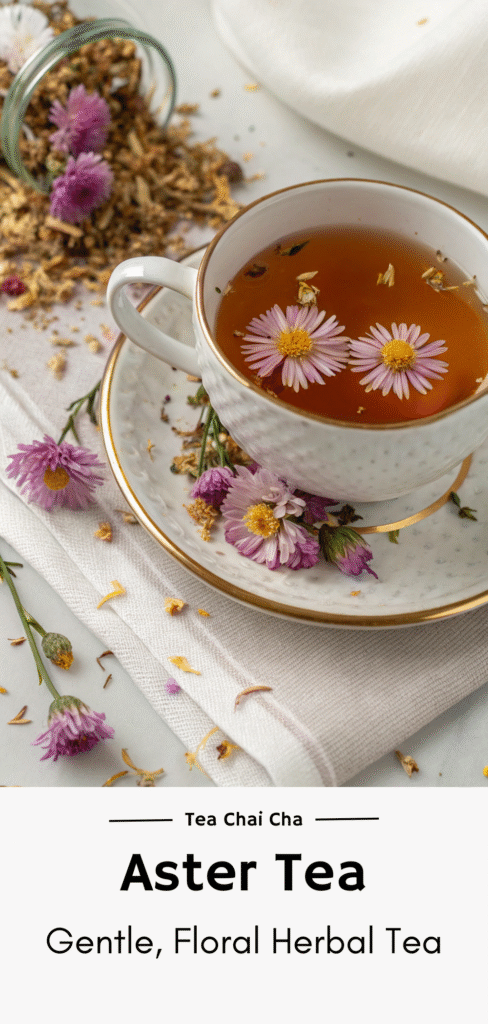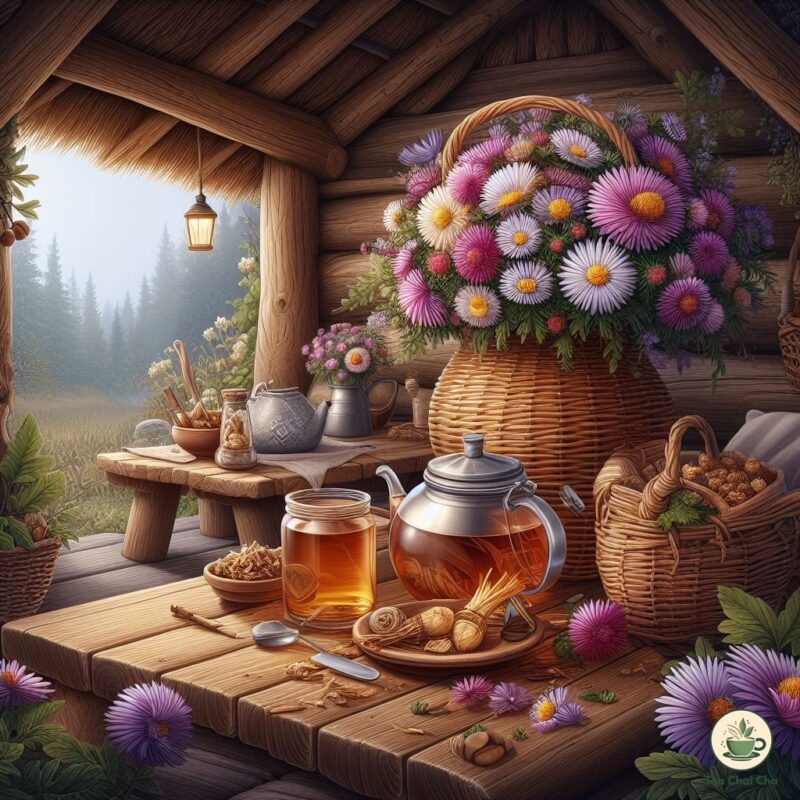Ever wake up and wish those mornings weren’t such a bloated battle?
Well, here’s a simple solution – swap out your usual cuppa for the gentle touch of aster tea.
Now, you might be thinking, “How do I make this herbal tea?“
Scroll down for a simple and quick recipe to introduce this beneficial beverage (I’m gonna talk about its benefits as well) into your daily life.

What Is Aster Tea?
Aster is a flowering plant that you can turn into a delightful cup of tea.
Its appearance is vibrant, with a variety of colors like purple, blue, pink, and white.
The history of aster traces back centuries, with Native Americans using it for medicinal purposes.
Aster tea is known for its potential to relieve respiratory issues, reduce inflammation, and improve digestion.
It’s a great source of antioxidants, which can boost your immune system.
In terms of habitat, asters can be found in various regions, from meadows to woodlands.
You might even spot them along roadsides.
This makes it relatively accessible for those interested in making their own aster tea.
How to Make Aster Tea – Step-by-Step Guide
If you’re looking to add a delightful twist to your tea routine, making Aster Tea is a perfect choice.
In just a few simple steps, you can create a cup of this fragrant and flavorful beverage.
Step 1: Gather Your Ingredients and Tools
To make a delicious cup of Aster Tea, you’ll need the following:
Ingredients:
- 1 tablespoon of dried aster flowers
- 1 teaspoon of honey (adjust to taste)
- 1 cup of hot water
Tools:
- Teapot or heat proof container with lid
- Strainer or tea infuser
- Teacup
Step 2: Prepare the Aster Flowers
Take your dried aster flowers and measure out 1 tablespoon.
If the flowers are whole, you can crush them slightly to release more flavor.
Step 3: Boil Water
Boil 1 cup of water. You can use a kettle or a saucepan for this.
Make sure the water is hot but not boiling vigorously.
Step 4: Infuse the Aster Flowers
Place the measured aster flowers into your teapot or heat proof container.
Pour the hot water over the flowers.
Cover with a lid to trap the aromatic flavors.
Let it steep for about 5-7 minutes.
Step 5: Strain and Sweeten
After steeping, use a strainer or tea infuser to separate the liquid from the aster flowers.
Discard the used flowers.
Now, add 1 teaspoon of honey to your liking. Stir well to dissolve.
Step 6: Enjoy Your Aster Tea
Pour your Aster Tea into your teacup, and savor the unique and floral flavors.
Take a moment to appreciate the soothing aroma as you enjoy your freshly brewed Aster Tea.
4 Types of Aster to Use in Aster Tea
If you’re considering making aster tea, it’s crucial to choose the right type of aster plant for the job.
Different aster varieties offer distinct flavors and potential health benefits.
Here’s a quick guide to help you pick the suitable aster for your tea.
1. Purple Aster (Aster novi-belgii)
Purple aster, also known as Michaelmas daisy, is a common choice for tea. It has a mild, slightly sweet taste.
When using this variety, focus on the flower petals for the best flavor.
Make sure to use fresh, vibrant petals for a satisfying cup of aster tea.
2. White Aster (Aster ericoides)
For a delicate and subtle flavor, consider using white aster in your tea.
The taste is mild, and it complements other herbal ingredients well.
To prepare white aster tea, utilize the flowers in moderation.
It can be a refreshing choice for those looking for a gentler herbal infusion.
3. New England Aster (Aster novae-angliae)
If you prefer a slightly earthy and robust flavor, go for the New England aster.
This variety adds a unique depth to your tea.
To make the most of its taste, include both the flowers and leaves in your tea blend.
Experiment with the ratio to find the balance that suits your palate.
4. Aster tataricus (Tatarian Aster)
For a tea with a more pronounced herbal note, try aster tataricus.
The leaves of this aster variety contribute to a bolder taste.
When making tea with aster tataricus, focus on the young leaves for the best flavor profile.
Can I Use Aster Leaves to Make Aster Tea?
Yes, you can make aster tea using leaves.
Aster tea prepared with leaves provides a distinct flavor profile, depending on the type of aster you choose.
Here’s how you can try making aster tea using leaves:
1. Choose the Right Aster Variety
Start by selecting an aster variety known for its flavorful leaves.
Varieties like New England aster (Aster novae-angliae) or Aster tataricus (Tatarian Aster) are suitable choices for leaf-based tea.
2. Harvest Fresh Leaves
Harvest young and healthy leaves from the aster plant.
These leaves typically contain more essential oils and flavors.
Ensure that you pick leaves from a source free of pesticides or contaminants.
3. Prepare the Leaves
Rinse the harvested leaves thoroughly under cold water to remove any dirt or debris.
You can use a clean paper towel to pat them dry.
4. Infusion Process
Place the fresh aster leaves in a teapot or tea infuser.
Use about 1 to 2 teaspoons of leaves per cup of water, depending on your taste preference.
5. Hot Water Infusion
Boil water and pour it over the aster leaves.
Allow the leaves to steep in the hot water for 5 to 10 minutes, depending on how strong you want the flavor.
Longer steeping times will result in a more robust taste.
6. Strain and Serve
After steeping, strain the tea to remove the leaves.
You can sweeten the tea with honey or add lemon if desired.
Serve it hot and enjoy your homemade aster tea with leaves.
How to Make Aster Tea Taste Good – 6 Drinks to Make!
Making aster tea tastes good involves a bit of creativity and the right combinations.
Elevate your tea experience by exploring different drinks you can make with aster tea.
1. Aster Mint Refresher
Brew a cup of Aster Tea following the basic recipe.
Add a handful of fresh mint leaves during the steeping process.
Strain and enjoy a revitalizing Aster Mint Refresher.
2. Chamomile Aster Blend
Combine dried chamomile flowers with your aster flowers (1:1 ratio).
Steep as usual and strain for a soothing Chamomile Aster Blend.
3. Lemon Infusion
Squeeze a lemon wedge into your brewed Aster Tea.
Stir well for a zesty twist. Enjoy a citrusy Lemon-Infused Aster Tea.
4. Hibiscus Aster Delight
Blend dried hibiscus petals with aster flowers for a vibrant mix.
Steep, strain, and experience the rich flavors of a Hibiscus Aster Delight.
5. Aster and Fruit Drink
Combine the subtle taste of aster tea with the natural sweetness of fruits.
Prepare a batch of aster tea and let it cool.
Add slices of fruits like peaches, berries, or citrus to infuse the tea with a delightful fruity flavor.
Chill in the fridge before serving.
6. Aster Tea Smoothie
Blend your aster tea with your favorite fruits to make a nutritious smoothie.
Combine cooled aster tea with bananas, berries, and a splash of yogurt.
Blend until smooth for a tasty and healthful beverage that incorporates the unique flavor of aster.
When to Drink Aster Tea
Aster tea is best consumed after meals to maximize its digestive benefits.
It aids in digestion and helps alleviate bloating.
Drinking it about 30 minutes after eating can support your digestive system.
Remember, consistency matters more than the specific time, so make it a regular post-meal routine for optimal results.
If you want its calming benefits, its best to drink it before bedtime.
Its relaxing properties can help you relax and improve sleep.
Avoid it in the morning as it might make you feel too relaxed for the day.
Related Herbal Tea Recipes
Aster Tea Recipe
Recipe by Tania FaysalCourse: DrinksCuisine: North American1
servings2
minutes7
minutes20
kcal9
minutesThis recipe uses dried aster flowers for steeping. Make this tea and enjoy its anti-inflammatory and inflammation alleviating properties.
Ingredients
1 tablespoon dried aster flowers
1 teaspoon honey (adjust to taste)
1 cup hot water
Directions
- Measure 1 tablespoon of dried aster flowers.
- Boil 1 cup of water in a kettle or saucepan.
- Place the aster flowers in a teapot, pour hot water, and cover with a lid. Steep for 5-7 minutes.
- Strain the tea into a cup, discard used flowers.
- Add 1 teaspoon of honey, stir well.
- Savor the aromatic and floral Aster Tea. Enjoy your moment of calm or share with a friend.
Recipe Video
Notes
- Fresh Aster Flowers: For a more vibrant flavor, consider using fresh aster flowers. Double the quantity to 2 tablespoons for an extra burst of freshness.
- Herbal Infusion: Experiment with additional herbs like mint or chamomile to complement the delicate notes of aster. Add a sprig of fresh mint during the steeping process for a refreshing twist.
- Iced Aster Tea: Make a refreshing iced version by allowing the steeped tea to cool and then pouring it over ice. Garnish with a lemon wedge for a citrusy kick.


